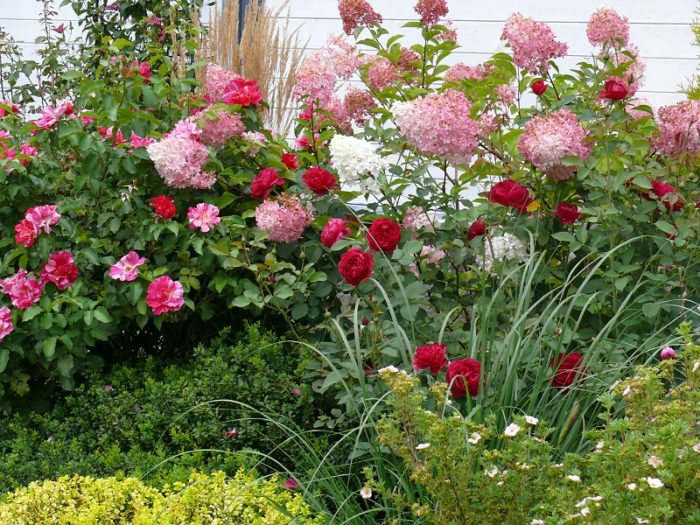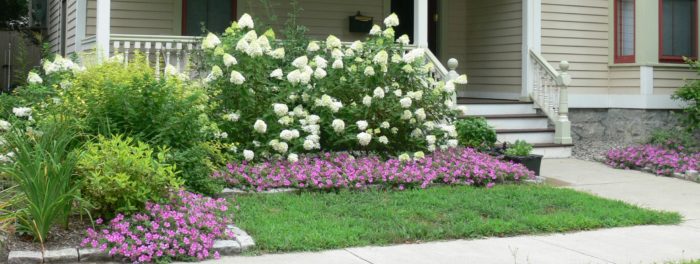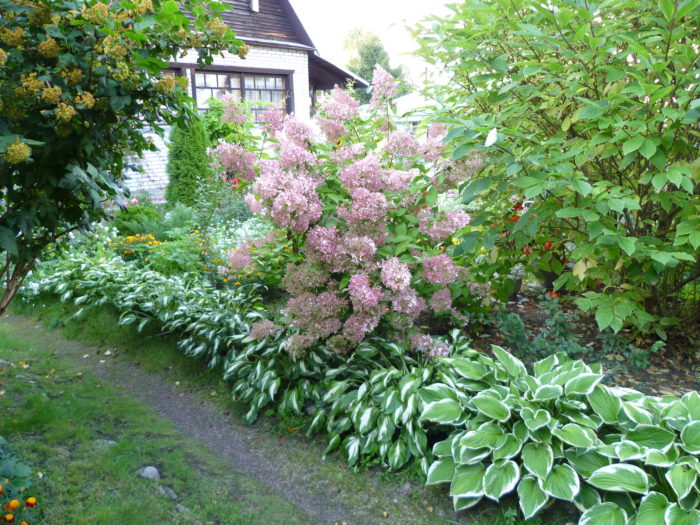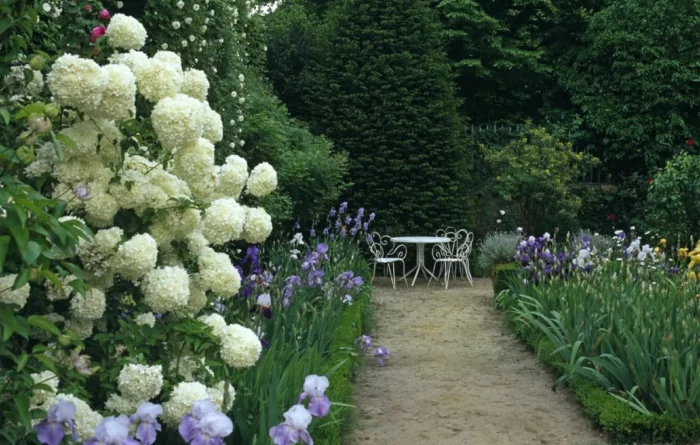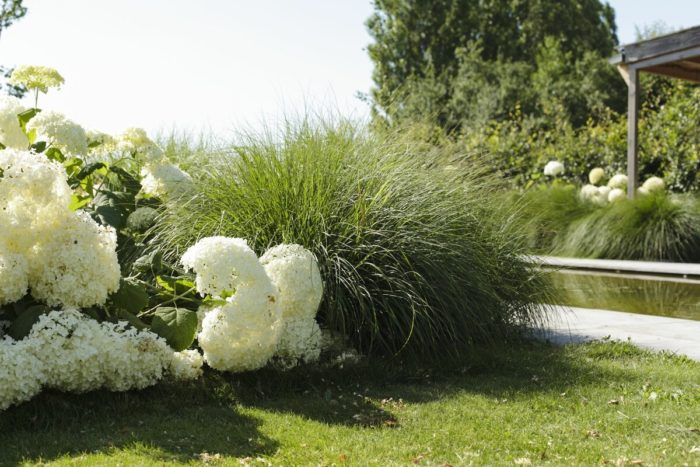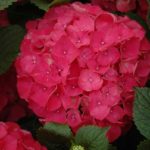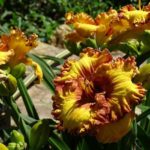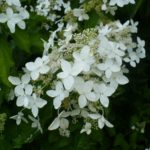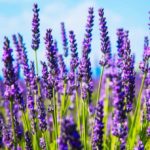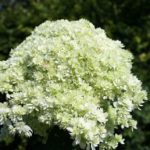Hydrangea is a beautiful garden plant that deservedly bears the name of the queen of the garden. A large number of varieties allows gardeners to choose the most suitable options. At the same time, quite often gardeners are interested in what exactly should be planted next to hydrangeas, which neighbors are good and bad. You should select add-ons with extreme care.
- Conditions for growing hydrangea
- Neighbors for paniculata hydrangea: roses, conifers, spirea
- Roses
- Conifers
- Spirea
- Neighbors for tree hydrangea: fruit trees, juniper, lilac
- Fruit trees
- Juniper
- Lilac
- Neighbors for large-leaved hydrangea
- Plants for planting under hydrangea: irises, astilbe, cereals, hosta
- Irises
- Astilbe
- Cereals
- Khosta
- Unwanted neighbors for hydrangeas
- Possibility of planting different types of hydrangeas nearby
Conditions for growing hydrangea
Ideal neighbors for hydrangea are crops that prefer the same living conditions. For normal growth, this flower needs the following conditions:
- Lighting – the flowering shrub is considered to be very light-loving. Lack of light negatively affects the duration of flowering. In addition, with a sufficient amount of light, it is possible to achieve more lush and bright flowering. At the same time, excess sun also has a bad effect on the flower. The ideal option would be a combination of light and partial shade. For example, the plant requires light from morning to noon, and partial shade in the afternoon.
- Watering – the ornamental shrub is considered moisture-loving. However, it cannot tolerate excess water. The plant is prohibited from being planted in lowlands where moisture accumulates. Water shortage also negatively affects the development of culture. You should not plant a flower near large bushes or trees. They will absorb most of the moisture from the soil. This will have a bad effect on the development of decorative culture.
- Soil - the flower requires a fertile, loose substrate, which has a slightly acidic reaction. The last condition is considered mandatory. In this case, the flower may die if the soil is highly acidic or alkaline. It is important that the acid reaction is weak.
When choosing neighbors, you should give preference to plants that need plenty of moisture and light. In addition, they should develop well in slightly acidic soil.
Neighbors for paniculata hydrangea: roses, conifers, spirea
Despite the special growth conditions, there are many options for a favorable neighborhood for this crop. The flower can be combined with perennials, small bushes and trees.It is important that plants do not compete for moisture and light. Thanks to this, they will be able to get along side by side.
So, when choosing neighbors, you should focus on the following criteria:
- Visual compatibility. Initially, you should give preference to plants that look harmonious with the capricious hydrangea. At the same time, crops should not absorb much moisture from their soil. An excellent solution would be a combination of a perennial flower or a low-growing shrub with a small root system.
- A combination of sun and shade. The culture is considered to be demanding in terms of lighting. At the same time, neighbors should not shade the bush very much. However, partial shade is still required. For example, it is permissible to plant small ornamental trees next to a flower.
- Requirements for soil composition. The crop requires slightly acidic soil. It is important that neighbors love the same land. Otherwise, each crop will have to create its own microclimate.
Roses
The flower looks great in combination with roses. It is important to take into account specific requirements. Bushes can compete for beneficial elements and moisture. Therefore, it is worth observing an interval between them. The watering and fertilizing schedule will vary. It should be installed taking into account the variety of plants planted.
Conifers
Conifers are considered an excellent backdrop for lush hydrangea blooms. They are undemanding to care and develop normally in acidified soil. If necessary, coniferous plants can shade the hydrangea. Suitable additions include spruces, dwarf pines, tall junipers and thuja. They should be planted at a distance of 1.5-1.7 meters from the hydrangea. It is best to do this from the south side. This way the conifers will shade the flower from the scorching sun.
To get a multi-level design, you should use juniper. Low-growing conifer looks good with flowering shrubs. The dark green branches of this plant perfectly set off the delicate flowers. If the juniper reaches a significant size, it should be pruned. Both plants need partial shade and a slightly acidified substrate. That's why they grow well nearby.
Spirea
The combination with spirea is considered popular among landscape designers. Spirea begins to bloom in the spring and ends in the first half of July. The hydrangea also blooms around the same time. This process ends only in the fall. This helps achieve the effect of continuous flowering, which gardeners love.
Crops need similar conditions, so there are no specific planting requirements. It is important to consider the height of the bushes. Spiraea is lower, so it cannot be shaded too much.
Neighbors for tree hydrangea: fruit trees, juniper, lilac
Tree hydrangea is distinguished by its considerable height. It resembles a tree that grows up to 2 meters. Impressive size is also characteristic of the lush inflorescences of the shrub.
Modest plants look good near such a crop. These can be hostas, astilbes, phloxes. It is also permissible to plant aconite, chinstrap, and sedum nearby. Fruit trees and large shrubs will be an excellent addition.
Fruit trees
You can safely place fruit trees near the tree-like variety of the flower. An apple tree planted on the south side will provide protection from drafts and bright sunlight. The minimum interval between a bush and a tree is 1.5 meters.
Juniper
Juniper would be a good addition. It can be used to create a multi-level design.The dark green crown of this crop perfectly complements the delicate flowers of hydrangea.
It is permissible to form contrasting ensembles with these plants. To do this, it is worth planting juniper, which has golden, blue or silver needles. If the bush grows too much, it is recommended to carry out formative pruning. Crops develop well when cultivated together because they have similar growing requirements. They should be planted in partial shade in acidified soil.
Lilac
Lilac is considered a good addition to hydrangea. These shrubs are distinguished by similar sizes and similar flowering. Lilac blooms in late spring, and hydrangea in summer. This makes it possible to get a flowerbed of continuous flowering. If desired, you can plant plants with similar colors or contrasting crops. With their help it is possible to create the effect of woven branches.
Neighbors for large-leaved hydrangea
This hydrangea is a tall tree that reaches 4 meters. Therefore, it is permissible to combine it with other shrubs - jasmine, hawthorn, turf, mackerel. The culture also looks good with bird cherry, boxwood, and cotoneaster. Low trees would be good additions to this type of plant. They can be used to create hedges and design paths.
It is important to place plants in such a way that they have enough free space and do not compete for lighting, water and fertilizing.
Plants for planting under hydrangea: irises, astilbe, cereals, hosta
To prevent the area under the plant from appearing bare, it is worth filling the free areas with shade-tolerant perennial flowers or ornamental grasses.
Irises
To get an unusual flower arrangement, you should surround the hydrangea with irises. However, they can only be planted next year after planting the hydrangea. This will help prevent overwatering.
Astilbe
Astilbe is considered an excellent addition to hydrangea. This plant is shorter in height than hydrangea. It develops in similar conditions and easily withstands shading. Both plants bloom over a long period of time. Inflorescences of various shapes harmonize perfectly with each other. In this case, it is permissible to choose flowers of similar shades or contrasting ones.
It is permissible to combine astilbe with hydrangea within a flower bed or form a hedge from them. The flower looks attractive even after flowering has ended. Its lacy leaves perfectly complement the rounded foliage of hydrangea.
Cereals
To obtain an unusual composition, it is worth planting ornamental grasses. They will not obscure the flower, since they bloom dimly. At the same time, cereals will be able to complement hydrangea flowers with decorative elongated leaves. They do not require special conditions. At the same time, cereals develop well in slightly acidic soil. However, it is important to avoid excessive swampiness. This is also required for hydrangea.
To emphasize the lush inflorescences of the flower, it is worth placing blue fescue, millet, and bulbous ryegrass next to it. Turfgrass and miscanthus are also good additions. Japanese forest grass helps create especially attractive combinations, since its delicate leaves can be distinguished by different colors - white, green or golden.
Khosta
Attractive hydrangea compositions are formed with hosts. They look good with variegated varieties.Hostas look great in the shade of hydrangeas because they do not withstand direct sunlight. Acidified soil is also suitable for them.
Unwanted neighbors for hydrangeas
Any crop planted too close is harmful. Unwanted neighbors include:
- tall trees;
- plants that require a lot of moisture;
- toxic crops;
- acacia.
Possibility of planting different types of hydrangeas nearby
Although there are many varieties of hydrangea, they have similar requirements for growing conditions. Therefore, they can be safely placed nearby. If you choose crops of different sizes that differ in color and flowering period, you will be able to get an unusual flower bed.
Hydrangea is a decorative crop that helps create different compositions. At the same time, you should be extremely careful when choosing neighbors for her.

